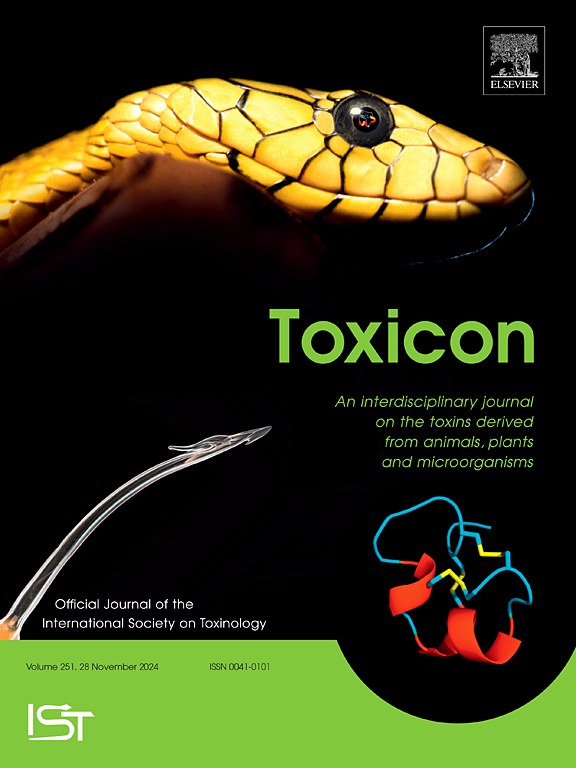通过调节TLR4/HMGB1/RAGE和NF-κB信号通路,青蒿素对胺碘酮引发的亚慢性肝毒性的药物治疗潜力:体内和计算机方法
IF 2.4
4区 医学
Q2 PHARMACOLOGY & PHARMACY
引用次数: 0
摘要
胺碘酮(AMI)已被广泛应用于心脏病患者,以预防危及生命的心律失常的发生。然而,它的过量使用会引起包括肝脏在内的各种器官损伤。青蒿素(ART)是一种具有巨大药用价值的类黄酮。本研究探讨了ART对急性心肌梗塞引起的亚慢性肝毒性的姑息潜力。将32只Sprague Dawley大鼠随机分为对照组、AMI (40 mgkg-1)、AMI (40 mgkg-1) + ART (1.5 mgkg-1)和ART (1.5mg/kg)单独治疗组。我们的研究结果表明,AMI引起严重的肝细胞炎症,其明显表现为白细胞介素-6 (IL-6)、晚期糖基化终产物受体(RAGE)、肿瘤坏死因子-α (TNF-α)、环氧化酶-2 (COX-2)、单核细胞趋化蛋白-1 (MCP-1)、高迁移率组盒1 (HMGB1)、白细胞介素-1β (IL-1β)、核因子-κB (NF-κB)、toll样受体4 (TLR4)的基因表达升高。AMI暴露提高了活性氧(ROS)和丙二醛(MDA)水平,抑制了超氧化物歧化酶(SOD)、血红素氧化酶-1 (HO-1)、谷胱甘肽还原酶(GSR)、谷胱甘肽过氧化物酶(GPx)、过氧化氢酶(CAT)和谷胱甘肽(GSH)的活性。AMI中毒使白蛋白和总蛋白水平降低,ALT、GGT、AST和ALP水平升高。此外,AMI加重了Caspase-9、Bax和Caspase-3,同时降低了Bcl-2浓度。AMI暴露后肝脏组织的正常形态被破坏。尽管如此,ART治疗通过调节上述生化和组织学损伤显著减轻了肝损伤。我们的研究结果表明,ART可以与这些蛋白的活性位点强烈相互作用,并表现出作为肝保护剂的潜力。本文章由计算机程序翻译,如有差异,请以英文原文为准。

Pharmacotherapeutic potential of artemetin against amiodarone instigated sub-chronic hepatotoxicity via modulating TLR4/HMGB1/RAGE and NF-κB signaling pathways: An in-vivo and in-silico approach
Amiodarone (AMI) has been widely used in cardiac patients to prevent the onset of life-threating cardiac arrhythmias. However, its excessive use induces various organ damages including the liver. Artemetin (ART) is a flavonoid that exhibits immense medicinal values. This investigation explored the palliative potential of ART against AMI induced sub-chronic hepato-toxicity. Thirty-two rats (Sprague Dawley) were randomly apportioned into control, AMI (40 mgkg−1), AMI (40 mgkg−1) + ART (1.5 mgkg−1) and ART (1.5 mg/kg) alone treated group. Our findings elucidated that AMI administration instigate severe hepatocellular inflammation which is evident by elevated gene expression of interleukin-6 (IL-6), receptor for advanced glycation end products (RAGE), tumor necrosis factor- α (TNF-α), cyclooxygenase-2 (COX-2), monocyte chemoattractant protein-1 (MCP-1), high mobility group box1 (HMGB1), interleukin-1β (IL-1β), nuclear factor-kappa B (NF-κB), toll-like receptor 4 (TLR4). AMI exposure promoted the levels of reactive oxygen species (ROS) and malondialdehyde (MDA) while suppressing the activities of superoxide dismutase (SOD), heme oxygenase-1 (HO-1), glutathione reductase (GSR), glutathione Peroxidase (GPx), catalase (CAT), and glutathione (GSH). Besides, AMI intoxication lowered the levels of albumin and total proteins while increasing the levels of ALT, GGT, AST, and ALP. Moreover, AMI administration exacerbated Caspase-9, Bax and Caspase-3 while diminishing Bcl-2 concentrations. The normal morphology of hepatic tissues was disrupted following the AMI exposure. Nonetheless, ART treatment significantly alleviated hepatic damage via regulating abovementioned biochemical as well as histological impairments. Our results demonstrated that ART can strongly interact with the active sites of these proteins and exhibit potential as hepatoprotective agent.
求助全文
通过发布文献求助,成功后即可免费获取论文全文。
去求助
来源期刊

Toxicon
医学-毒理学
CiteScore
4.80
自引率
10.70%
发文量
358
审稿时长
68 days
期刊介绍:
Toxicon has an open access mirror Toxicon: X, sharing the same aims and scope, editorial team, submission system and rigorous peer review. An introductory offer Toxicon: X - full waiver of the Open Access fee.
Toxicon''s "aims and scope" are to publish:
-articles containing the results of original research on problems related to toxins derived from animals, plants and microorganisms
-papers on novel findings related to the chemical, pharmacological, toxicological, and immunological properties of natural toxins
-molecular biological studies of toxins and other genes from poisonous and venomous organisms that advance understanding of the role or function of toxins
-clinical observations on poisoning and envenoming where a new therapeutic principle has been proposed or a decidedly superior clinical result has been obtained.
-material on the use of toxins as tools in studying biological processes and material on subjects related to venom and antivenom problems.
-articles on the translational application of toxins, for example as drugs and insecticides
-epidemiological studies on envenoming or poisoning, so long as they highlight a previously unrecognised medical problem or provide insight into the prevention or medical treatment of envenoming or poisoning. Retrospective surveys of hospital records, especially those lacking species identification, will not be considered for publication. Properly designed prospective community-based surveys are strongly encouraged.
-articles describing well-known activities of venoms, such as antibacterial, anticancer, and analgesic activities of arachnid venoms, without any attempt to define the mechanism of action or purify the active component, will not be considered for publication in Toxicon.
-review articles on problems related to toxinology.
To encourage the exchange of ideas, sections of the journal may be devoted to Short Communications, Letters to the Editor and activities of the affiliated societies.
 求助内容:
求助内容: 应助结果提醒方式:
应助结果提醒方式:


